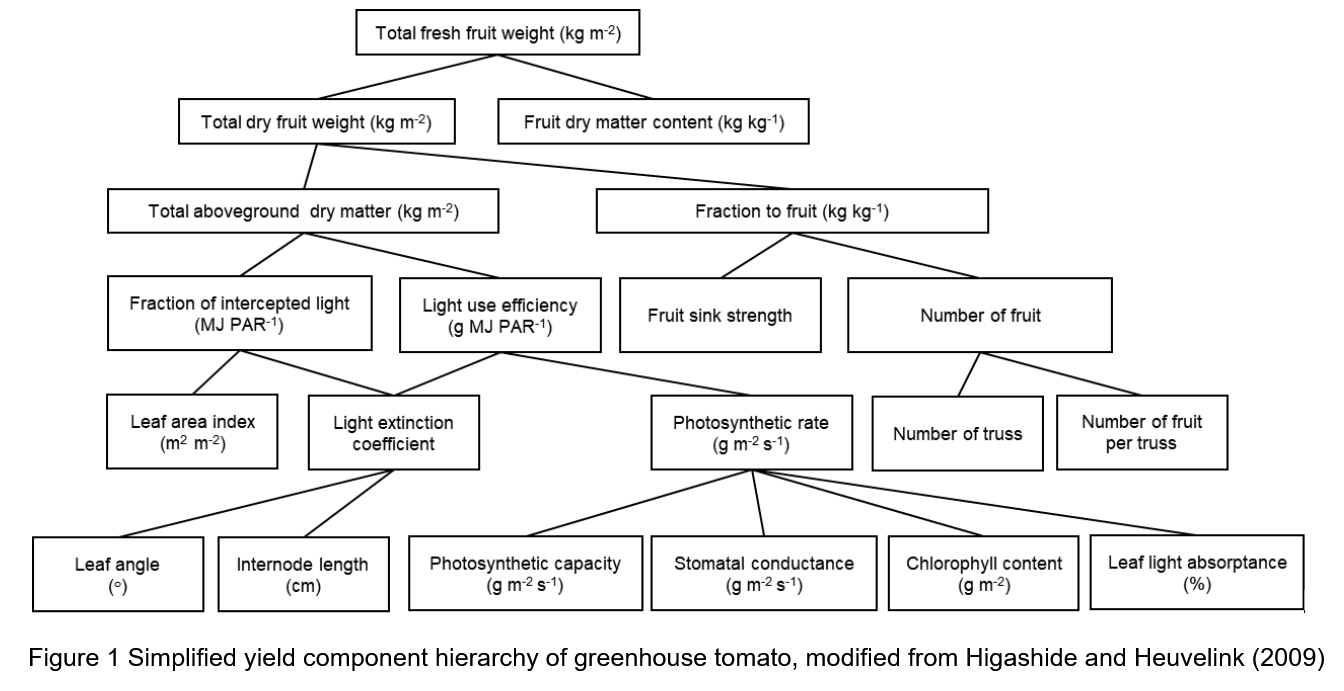Paul Kasemsap
พรพิพัฒน์ เกษมทรัพย์

~growing plants for improved wellbeing
Changes in photosynthetic and other yield components contributing to yield improvement of Dutch tomato
This is an excerpt from a thesis abstract webpage first published by Chair Group Horticulture and Product Physiology, Wageningen University in June 2015.
Kasemsap, P. 2015. Changes in photosynthetic and other yield components contributing to yield improvement of Dutch tomato. Master thesis. (MSc. in Plant Sciences at Wageningen University, the Netherlands).

Abstract
Dutch greenhouse tomato (Solanum lycopersicum) yield continuously improves due to favourable growth conditions and breeding. Changes in leaf photosynthesis and light extinction coefficient (k) in modern cultivars were proposed to underlie this improvement. To validate this conclusion, yield and photosynthetic components of six round tomato cultivars, released between 1975 and 2013, were
analysed in a greenhouse experiment from June to December in 2014 at Wageningen University, The Netherlands. An increase in yield of 1 % per year with the year of release was mainly caused by a decrease in fruit dry matter content of 0.03% per year. Total fruit dry weight and total aboveground dry matter increased with the year of release. Canopy light interception and light use efficiency
improved with the year of release because of higher leaf area index, reduced k, and enhanced leaf photosynthetic rate in modern cultivars. Reduced k was characterized by an increase in internode length. Higher leaf photosynthesis was observed in both top and middle leaf layer. Photosynthetic capacity increased 0.4 % per year and was positively correlated with leaf chlorophyll content and light absorptance. In conclusion, modern cultivars possess characteristics which make them capable
to maintain high long-term productivity with current greenhouse technology.
Keywords: Breeding, Yield component, Dry matter production, Dry matter partitioning, Leaf area index, Light use efficiency, Light interception, Light extinction coefficient, Photosynthesis, Chlorophyll, Light absorptance
category:news tag:
science plant gradschool publication Read more thoughts:
-
Genome-wide Association Study of Rice Vegetative Growth under Ammonium or Nitrate Nutrition (31 Jul 2025)
-
The inaugural Bay Area Plant Hub Symposium 2025 (17 Apr 2025)
-
How can we cultivate an innovative plant science community? (16 Apr 2025)
-
[Dataset] Vegetative biomass production under different inorganic nitrogen forms of the USDA rice (Oryza sativa L.) diversity panel 1 (17 Mar 2025)
-
Mission N-Possible: Influence of Inorganic Nitrogen Forms on Small Grain Crop Carbon Assimilation (13 Sep 2024)
-
Genome-wide Association Study of Rice Vegetative Biomass under Different Inorganic Nitrogen Forms: Ammonium or Nitrate (13 Aug 2024)
-
Genetic adaptation to ammonium sustains wheat grain quality and alleviates acclimation to CO2 enrichment (23 Nov 2023)
-
Sharing research data (25 Jan 2023)
-
Breeding for Higher Yields of Wheat and Rice through Modifying Nitrogen Metabolism (23 Dec 2022)
-
Giving credit where it's due (18 Nov 2022)
-
Lessons beyond classroom: 12 opportunities to grow a better self while in college (10 Aug 2022)
-
Everything, Everywhere, All at Once (01 Aug 2022)
-
UC Davis Plant Sciences Symposium 2022 Award Winners Announced - Paul gave the best student talk! (27 Jun 2022)
-
I was told that: It's what you do that defines you. Is it? (20 May 2022)
-
I was told that: Opportunity is like a bus (20 May 2022)
-
Can we use personalized ads to improve our decision? (12 May 2022)
-
If you could choose better, would you? (12 May 2022)
-
How pottery helps me write (10 May 2022)
-
We need more conflicts (08 May 2022)
-
Rate My Lab! - A yelp-like platform to grade your advisor? (01 May 2022)
-
Life outside the lab - exploring passion projects beyond research (27 Apr 2022)
-
Thought of the week: Trash hunt squad? (22 Apr 2022)
-
Never have I ever… coded (and wondered into the world of data science) (18 Feb 2022)
-
Where do we get protein in our daily diets? (01 Jun 2021)
-
ภาษาไทย (15 May 2021)
-
Hello World (13 May 2021)
-
Find a talk - What if we can find all the talks in the world? (09 May 2021)
-
Meet Public Scholarship and Engagement Prize Winner: Paul Kasemsap (19 Apr 2021)
-
Meet the Fulbrighters Series: Pure & Applied Science - Paul joined a panel sharing Fulbright experience in the USA (30 Mar 2021)
-
Meet Paul Kasemsap, Horticulture & Agronomy Graduate Student and Grad Slam Finalist (19 Mar 2021)
-
ชีวิตติดโชค (01 Nov 2020)
-
ไนโตรเจน...ธาตุอาหารพืชเปลี่ยนโลก (05 Aug 2020)
-
Grad Innovator Fellowship 2020: Meeting Global Protein Demands and Optimizing Resources in the Face of Climate Change (01 Apr 2020)
-
Rising atmospheric CO2 concentration inhibits nitrate assimilation in shoots but enhances it in roots of C3 plants (23 Oct 2019)
-
UC Davis Plant Breeding Center Graduate Student Spotlight (01 Jun 2018)
-
“ไบเออร์” สร้างยุวชนเกษตร รับมือปัญหาความมั่นคงทางอาหาร (15 Nov 2017)
-
2 ยุวชน..หัวใจเกษตร กับเวทีสำคัญ..ภารกิจช่วยโลก!! (12 Nov 2017)
-
การประชุมสุดยอดยุวชนเกษตร (Youth Ag-Summit) ปี พ.ศ. 2560 (27 Oct 2017)
-
Characterisation of Arabidopsis thaliana candidate genes putatively involved in the response to salt stress (08 Jul 2015)
-
First day of class in Wageningen (21 Jun 2015)
-
A year in Wageningen UR (19 Jun 2015)
-
Fietsen are sustainable! (18 Jun 2015)
-
Changes in photosynthetic and other yield components contributing to yield improvement of Dutch tomato (01 Jun 2015)
-
การเดินทางจากสนามบิน Schiphol สู่ Wageningen (12 Aug 2013)
-
The appropriate supporting material for micropropagated Vanilla planifolia Jacks. ex Andrews plantlet (08 May 2013)
-
Effect of Drought Stress on Chlorophyll Fluorescence and Net CO2 Exchange Rate of Vanilla planifolia Jacks. ex Andrews (25 Mar 2013)